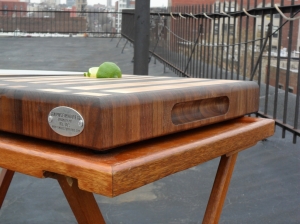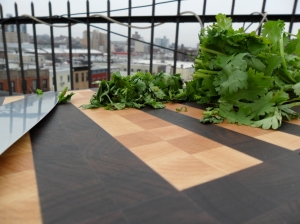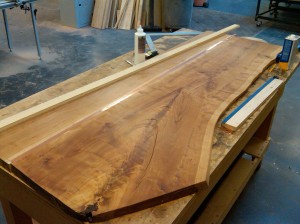Right now I have a couple projects in the hopper. Some to finish, and some that are new. Plan to have all completed early in the New Year.
Low Credenza
Just about all set, but still need to build the (pricey) copper frame and a few more modifications to the slab. I need to drill a half circle through it on the back so that cords can pass up to the TV and the slab be flush against the wall, and add the butterfly to prevent the crack from growing. I also need to rout some shallow grooves to hold a cushion in place when I use it for seating (i.e. party time), as well as fabricate something to put in those grooves when no cushion (i.e. book time). To go with that, I'll mount a cushion on the wall. Once I have the frame, I'll also drill some very shallow holes to keep it in place and not sliding around and accommodate the 4 rubber stops that will support it.
Here's the latest of it in situ. On its paint can frame. With the copper frame, the surface will be about about 3" higher, the boxes will remain at approximately the same height. The radio below TV will also go and clean up the look a bit once some other audio projects are finished.
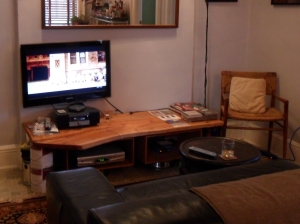
I designed the cherry boxes below to be able to accommodate rack-mount sized components. Why, at this p0int, I'm really not sure, because, as you can see, I don't have any. But you can imagine in the future those will be chock full of blinking lights.
Bike Rack
Done. Take a look:
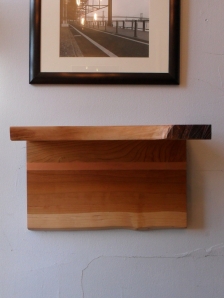


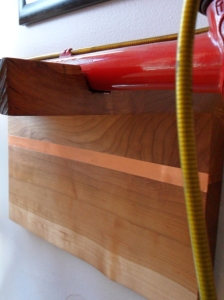

I used Plasti Dip (the rubber material on things like pliers) to line the channel rather than using bicycle inner tube. (Note from the fourth picture that the top tube isn't resting on the copper, only the rubber.) Inner tube was a clever idea, and would have been a great way to re-purpose materials, but too tough to get something that was never intended to be a flat surface to behave as a flat surface. I was thinking I could build some sort of jig to keep it under tension while gluing, then release it and trim the excess, but just too complicated for the time being.
I have it currently tanning perched on my windowsill. A friend of mine saw it as he was driving up 3rd Avenue. Thought it a bit odd. Been just a few sessions, and it still looks a little blah, but even with just a few hours the color is getting a deeper. Still considering some sort of hooks to hold helmets and such, but reconsidering and think they may be a bit impractical if the bike rack is hung at a low height (e.g. waist level).
Shelving System
This moving along. I was able to get the walnut plywood delivered to the shop on Monday. Free delivery is great, but only if they're in the area. Thankfully it all worked out and was far superior to me carrying a 4' x 8' sheet of 1" thick plywood down 3rd ave from my apartment. Ugh.
This particular piece is going to be for a kitchen and a combination of a pot rack and shelving system. The following picture gives the gist of how the shelves will work. Just think thicker walnut plywood and imagine a shallow channel in the underside of the plywood that fits over the pipe and keeps the shelf in place.
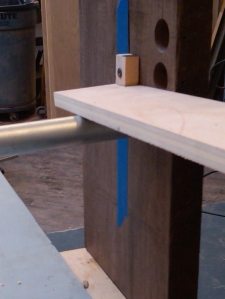
Here are some more shots of the current project. The bottom two thirds of the vertical piece on the left will eventually be removed. There will be two pipes spanning the entire width, and an additional three on the right side for a total of five.
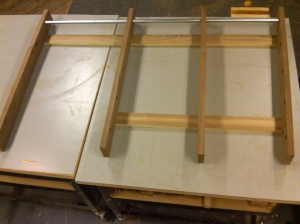
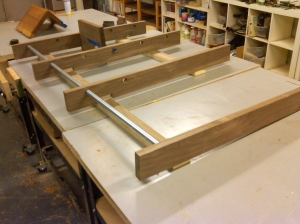
Cutting Boards
I've been looking to make some very substantial end-grain cutting boards for a while now. I'm want to monogram the cutting boards with initials in a sort of Morse code "barcode". Dots will be a stripe 1x wide, a dash is 2x wide. New but timeless. Personalized for you. Walnut and maple. This boards will also be thick - 2".
There's are lots of really cool end grain boards out there. I like them quite a bit, but want something more substantial.
I also intend to do custom boards that will fit over your sink! Wow! Here are the plans for the two I'm working on now.
This is one for a friend:

This will be one for me.
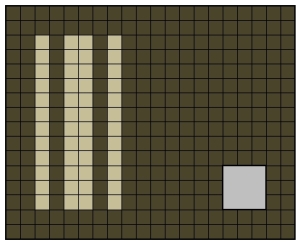
The stripes say "R" (I might move them right a bit, not sure yet) and that little square on the bottom left is a 3" x 3" hole under which one of those Wonton soup containers will fit just right. I can then chop my onions and the skins go into the hole and into the container. My kitchen has - no joke - 2.22 square feet of counter space. This cutting board over my sink would increase my counter space by 100%.
Both of these will be close to 16" x 20", and about 2" thick. Heavy. No joke. But the last one you'll ever need. And the surface will be soooooo smooth.
What do you think?]]>



